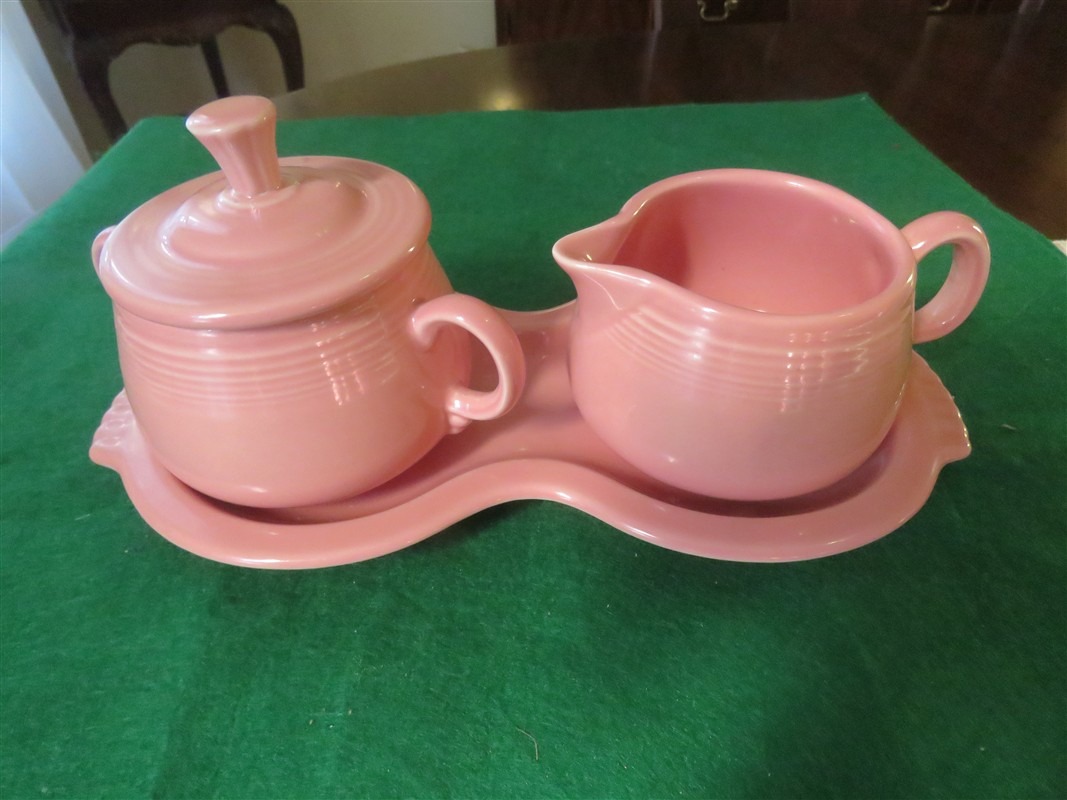Origins (1930s)
-
Introduced in 1936 by the Homer Laughlin China Company of Newell, West Virginia.
-
Designed by Frederick Hurten Rhead, an English-born potter.
-
At the time, most dinnerware was floral, ornate, or delicate. Fiestaware broke tradition with bold, solid colors and simple Art Deco–inspired shapes.
-
It was sold as open-stock dinnerware, meaning customers could buy individual pieces rather than whole sets—revolutionary for the time.
Early Colors & Popularity
-
The first colors were red, cobalt blue, light green, ivory, and yellow.
-
Later additions included turquoise (1938) and others over time.
-
The line became hugely popular, partly because the Great Depression had ended and Americans were ready for bright, affordable, mix-and-match tableware that felt modern.
The Radioactive Red (1940s–1950s)
-
One of Fiestaware’s most famous quirks was its bright orange-red glaze, which got its vivid color from uranium oxide.
-
This glaze was made until World War II, when uranium was seized by the government for atomic research.
-
After the war, a different (but still slightly radioactive) glaze was used until the early 1970s, when regulations tightened. Today, collectors seek out these vintage pieces, though they are considered safe for display rather than daily use.
Decline & Retirement (1960s–1970s)
-
By the 1960s, tastes shifted toward more muted, patterned dinnerware.
-
Homer Laughlin tried new pastel and earth-tone colors, but sales declined.
-
In 1973, Fiesta was discontinued, and it seemed like its era was over.
Revival (1986–Present)
-
To celebrate its 50th anniversary in 1986, the company reintroduced Fiesta with updated, lead-free glazes.
-
The relaunch was a massive success—Americans felt nostalgia, and younger buyers loved its retro-modern look.
-
Since then, new colors are introduced almost every year while older ones are retired, creating a collector’s culture around Fiestaware.
Today
-
Fiesta remains America’s most collected dinnerware line.
-
It’s still produced in Newell, WV, making it one of the few enduring examples of American-made ceramics.
-
With its mix of history, color, and collectibility, Fiesta isn’t just dinnerware—it’s part of American cultural heritage.
Most Coveted Colors
-
Medium Green (1959–1969)
Widely regarded as the rarest and most collectible vintage Fiestaware color. Its limited production run and dwindled availability on the secondary market make it especially valuable. EstateSales.orgVoyage To VintageWikipedia -
Original Red (1936–1943 vintage pieces)
Also highly prized, particularly vintage uranium-glaze pieces from before WWII. Its rarity and distinctive hue contribute to premium pricing. Voyage To VintageWikipediaFiestaware Collector -
Original Colors (Red, Cobalt, Light Green, Yellow, Ivory, plus Turquoise, Chartreuse, Rose, Grey, Forest Green)
These debut-era or mid-century shades are generally more valuable across shapes. EstateSales.orghappyheidi.comCountry LivingWikipedia
Rare Shapes & Specialty Pieces
According to multiple sources, certain forms command higher prices due to limited runs or early discontinuation:
-
Cake Plate (circa 1936)
Extremely rare—especially in Red—often valued around $3,000+. happyheidi.com -
Pitcher: Disc Juice (Vintage)
Particularly rare in gray. A standard example in gray may fetch up to $2,500. happyheidi.com -
Medium Green Jug (2-Pint) & Disc Water Pitcher
Notably valuable—medium green variants often exceed $1,750. happyheidi.com -
Flower Vases (Original sizes, 8″, 10″, 12″)
Turquoise and Red versions especially desirable; 10″ pieces can go for $1,200 each. Country Living
A 12″ vase in Vintage Original Green may fetch $1,750. vintageamericanpottery.com -
Relish Tray with Inserts
A complete set (tray + 5 inserts) can be worth around $500, while individual inserts go for about $80 each. Country Living -
Marmalade Jar (Vintage)
Valued at around $400, due to early discontinuation. Country Living -
Demitasse Coffeepot
Discontinued in 1942 and hard to find; appraised around $600. Country Living
Price Estimates and Market Snapshots
-
Vintage Pieces (Thrift/eBay range):
Plates and bowls typically go for $10–$50.
Specialty serveware, like casserole dishes, can fetch up to $250. The Sun -
Mixed Sets (~52 pieces):
A full set might fetch $2,000–$2,500. Breaking them up:-
Dinner plates: $40–$45 each
-
Bread & butter plates / fruit bowls: $10–$15
-
Cereal/soup bowls: $50–$55
-
Chop plates / platters: $25–$35
-
Large turquoise pitcher: $75–$100
-
Medium green sugar & creamer: $100–$125
JustAnswer
-
-
eBay High-End Listings:
Limited-run Lilac 12″ pasta bowls (c. 1995) average around $131.68, though individual items range broadly. Fiestaware Collector+1 -
General Sentiment:
Vintage Fiestaware, especially rare colors or shapes, continues to appreciate in value among collectors. Southern LivingThe SunWikipedia
Collector’s Rarity & Value Summary (Table)
| Category | Examples/Colors | Estimated Value |
|---|---|---|
| Rarest Colors | Medium Green, Original Red | Highest premiums |
| Rare Vintage Shapes | Cake Plate, Disc Juice Pitcher, vases | $1,200–$3,000+ |
| Specialty Sets | Relish Tray w/Inserts, Marmalade Jar, Coffeepot | $400–$600 |
| Common Vintage Pieces | Plates, bowls, sets | $10–$55+ each, full set $2–2.5K |
| Limited Modern Runs | Lilac (c. 1995) | ~$130+ depending on piece |
Tips for Collectors & Sellers
-
Confirm authenticity and vintage era, especially for Medium Green and Original Red—they drive value.
-
Condition matters immensely: chips, glaze wear, and crazing can significantly impact resale.
-
Complete and rare sets (like relish trays or specific pitch pitchers) are highly desirable.
-
Use selling channels wisely: eBay and specialized auctions attract serious collectors willing to pay premiums.
-
Check up-to-date price guides and collector forums for trends and comparables. Reddit
Fiestaware is still made today by the Homer Laughlin China Company, which now operates under the name The Fiesta Tableware Company.
-
The company is based in Newell, West Virginia, where all Fiesta has been produced since its launch in 1936.
-
In 2020, Homer Laughlin rebranded itself as The Fiesta Tableware Company to highlight its flagship product.
-
Fiesta dinnerware is still American-made—one of the few major dinnerware brands that hasn’t moved production overseas.
-
Every year, they continue the tradition of releasing a new color while retiring an older one, keeping the line fresh for collectors and new buyers.


